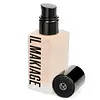What's inside
What's inside
 Key Ingredients
Key Ingredients

 Benefits
Benefits

 Concerns
Concerns

 Ingredients Side-by-side
Ingredients Side-by-side

Water
Skin ConditioningCyclopentasiloxane
EmollientIsohexadecane
EmollientGlycerin
HumectantTridecyl Trimellitate
EmollientMica
Cosmetic ColorantPropylene Glycol
HumectantIsononyl Isononanoate
EmollientVinyl Dimethicone/Methicone Silsesquioxane Crosspolymer
Trimethylsiloxysilicate
EmollientDimethicone
EmollientCetyl PEG/PPG-10/1 Dimethicone
EmulsifyingPhenyl Trimethicone
Skin ConditioningBoron Nitride
AbsorbentSodium Chloride
MaskingSilica Dimethyl Silylate
EmollientPEG-10 Dimethicone
Skin ConditioningSynthetic Fluorphlogopite
Silica
AbrasiveSorbitan Sesquioleate
EmulsifyingDisteardimonium Hectorite
StabilisingTriethoxycaprylylsilane
Propylene Carbonate
SolventAcrylates/Dimethicone Copolymer
Skin ConditioningMethicone
EmollientTocopheryl Acetate
AntioxidantPhenoxyethanol
PreservativeEthylhexylglycerin
Skin ConditioningParfum
MaskingTitanium Dioxide
Cosmetic ColorantIron Oxides
Water, Cyclopentasiloxane, Isohexadecane, Glycerin, Tridecyl Trimellitate, Mica, Propylene Glycol, Isononyl Isononanoate, Vinyl Dimethicone/Methicone Silsesquioxane Crosspolymer, Trimethylsiloxysilicate, Dimethicone, Cetyl PEG/PPG-10/1 Dimethicone, Phenyl Trimethicone, Boron Nitride, Sodium Chloride, Silica Dimethyl Silylate, PEG-10 Dimethicone, Synthetic Fluorphlogopite, Silica, Sorbitan Sesquioleate, Disteardimonium Hectorite, Triethoxycaprylylsilane, Propylene Carbonate, Acrylates/Dimethicone Copolymer, Methicone, Tocopheryl Acetate, Phenoxyethanol, Ethylhexylglycerin, Parfum, Titanium Dioxide, Iron Oxides
Water
Skin ConditioningCyclopentasiloxane
EmollientIsododecane
EmollientGlycerin
HumectantAlcohol
AntimicrobialPhenyl Trimethicone
Skin ConditioningAluminum Starch Octenylsuccinate
AbsorbentBis-Hydroxyethoxypropyl Dimethicone/Ipdi Copolymer Ethylcarbamate
Cetyl PEG/PPG-10/1 Dimethicone
EmulsifyingDisteardimonium Hectorite
StabilisingSodium Chloride
MaskingPolyglyceryl-4 Isostearate
EmulsifyingHexyl Laurate
EmollientDi-C12-13 Alkyl Tartrate
EmollientSodium Dehydroacetate
PreservativePotassium Sorbate
PreservativeDisodium Stearoyl Glutamate
CleansingDiamond Powder
AbrasiveCaprylic/Capric Triglyceride
MaskingAluminum Hydroxide
EmollientPentaerythrityl Tetra-Di-T-Butyl Hydroxyhydrocinnamate
AntioxidantRubus Idaeus Leaf Cell Culture
Skin ConditioningCI 77891
Cosmetic ColorantCI 77491
Cosmetic ColorantCI 77492
Cosmetic ColorantCI 77499
Cosmetic ColorantWater, Cyclopentasiloxane, Isododecane, Glycerin, Alcohol, Phenyl Trimethicone, Aluminum Starch Octenylsuccinate, Bis-Hydroxyethoxypropyl Dimethicone/Ipdi Copolymer Ethylcarbamate, Cetyl PEG/PPG-10/1 Dimethicone, Disteardimonium Hectorite, Sodium Chloride, Polyglyceryl-4 Isostearate, Hexyl Laurate, Di-C12-13 Alkyl Tartrate, Sodium Dehydroacetate, Potassium Sorbate, Disodium Stearoyl Glutamate, Diamond Powder, Caprylic/Capric Triglyceride, Aluminum Hydroxide, Pentaerythrityl Tetra-Di-T-Butyl Hydroxyhydrocinnamate, Rubus Idaeus Leaf Cell Culture, CI 77891, CI 77491, CI 77492, CI 77499
 Reviews
Reviews

Ingredients Explained
These ingredients are found in both products.
Ingredients higher up in an ingredient list are typically present in a larger amount.
This ingredient is a high molecular weight silicone. It has emulsifying and skin conditioning properties.
Cyclopentasiloxane, or D5, is a silicone used to improve texture of products and trap moisture.
D5 is considered lightweight and volatile. Volatile means it evaporates quickly after application. Once evaporated, D5 leaves a thin barrier that helps keep skin hydrated.
It is also an emollient. Emollients help soften the skin and prevent water loss. Silicones create a silky texture in products. D5 helps other ingredients become more spreadable.
Studies show D5 is safe to use in skincare products. We recommend speaking with a skincare professional if you have concerns.
Learn more about CyclopentasiloxaneDisteardimonium Hectorite comes from the clay mineral named hectorite. It is used to add thickness to a product.
It can also help stabilize a product by helping to disperse other ingredients.
Hectorite is a rare, white clay mineral.
Learn more about Disteardimonium HectoriteGlycerin is already naturally found in your skin. It helps moisturize and protect your skin.
A study from 2016 found glycerin to be more effective as a humectant than AHAs and hyaluronic acid.
As a humectant, it helps the skin stay hydrated by pulling moisture to your skin. The low molecular weight of glycerin allows it to pull moisture into the deeper layers of your skin.
Hydrated skin improves your skin barrier; Your skin barrier helps protect against irritants and bacteria.
Glycerin has also been found to have antimicrobial and antiviral properties. Due to these properties, glycerin is often used in wound and burn treatments.
In cosmetics, glycerin is usually derived from plants such as soybean or palm. However, it can also be sourced from animals, such as tallow or animal fat.
This ingredient is organic, colorless, odorless, and non-toxic.
Glycerin is the name for this ingredient in American English. British English uses Glycerol/Glycerine.
Learn more about GlycerinPhenyl Trimethicone is a silicon-based polymer. It is derived from silica.
Phenyl Trimethicone is used as an emollient and prevents products from foaming.
As an emollient, it helps trap moisture in the skin. It is considered an occlusive.
Learn more about Phenyl TrimethiconeChances are, you eat sodium chloride every day. Sodium Chloride is also known as table salt.
This ingredient has many purposes in skincare: thickener, emulsifier, and exfoliator.
You'll most likely find this ingredient in cleansers where it is used to create a gel-like texture. As an emulsifier, it also prevents ingredients from separating.
There is much debate on whether this ingredient is comedogenic. The short answer - comedogenic ratings don't tell the whole story. Learn more about comegodenic ratings here.
The concensus about this ingredient causing acne seems to be divided. Research is needed to understand if this ingredient does cause acne.
Scrubs may use salt as the primary exfoliating ingredient.
Learn more about Sodium ChlorideWater. It's the most common cosmetic ingredient of all. You'll usually see it at the top of ingredient lists, meaning that it makes up the largest part of the product.
So why is it so popular? Water most often acts as a solvent - this means that it helps dissolve other ingredients into the formulation.
You'll also recognize water as that liquid we all need to stay alive. If you see this, drink a glass of water. Stay hydrated!
Learn more about Water